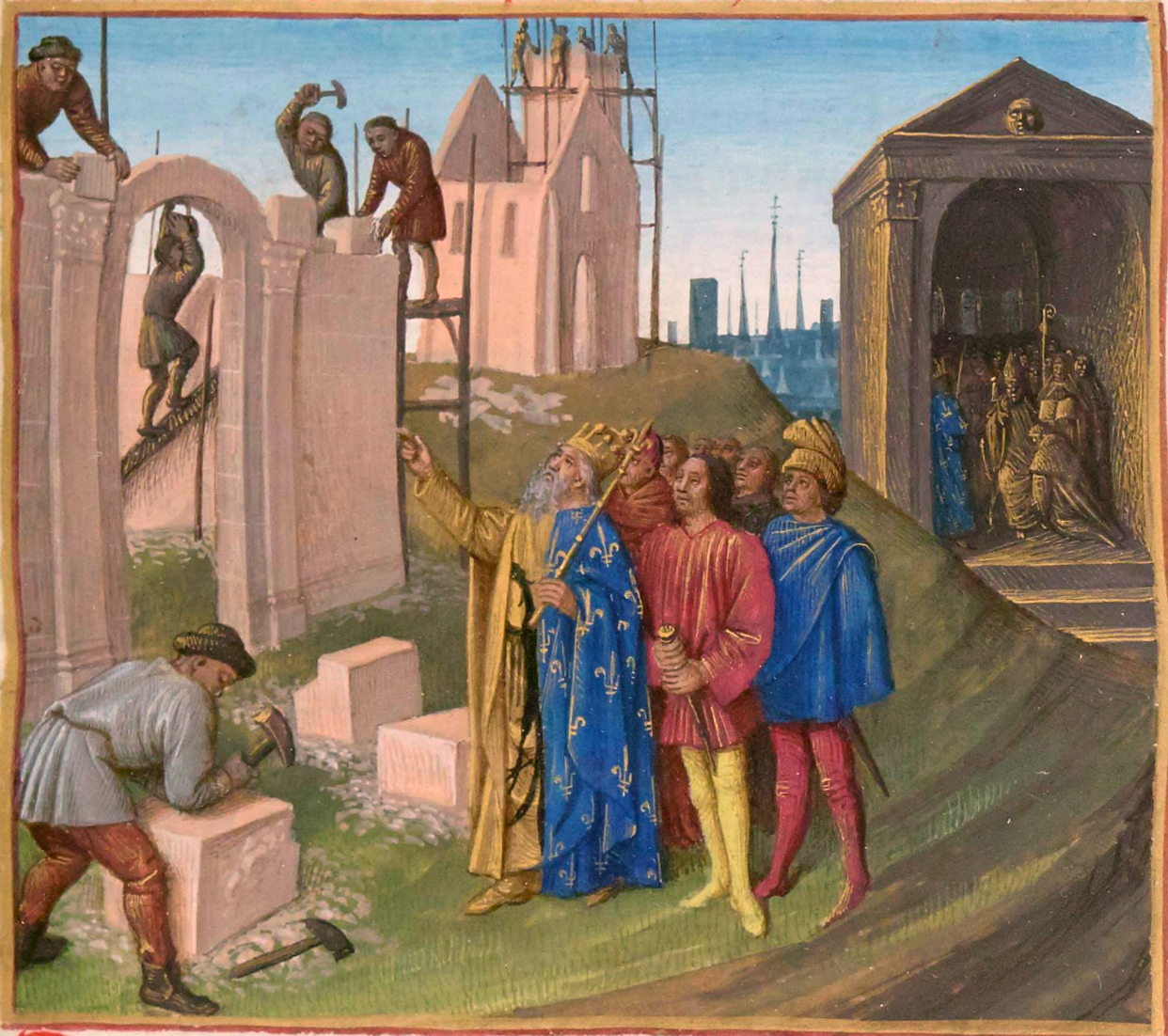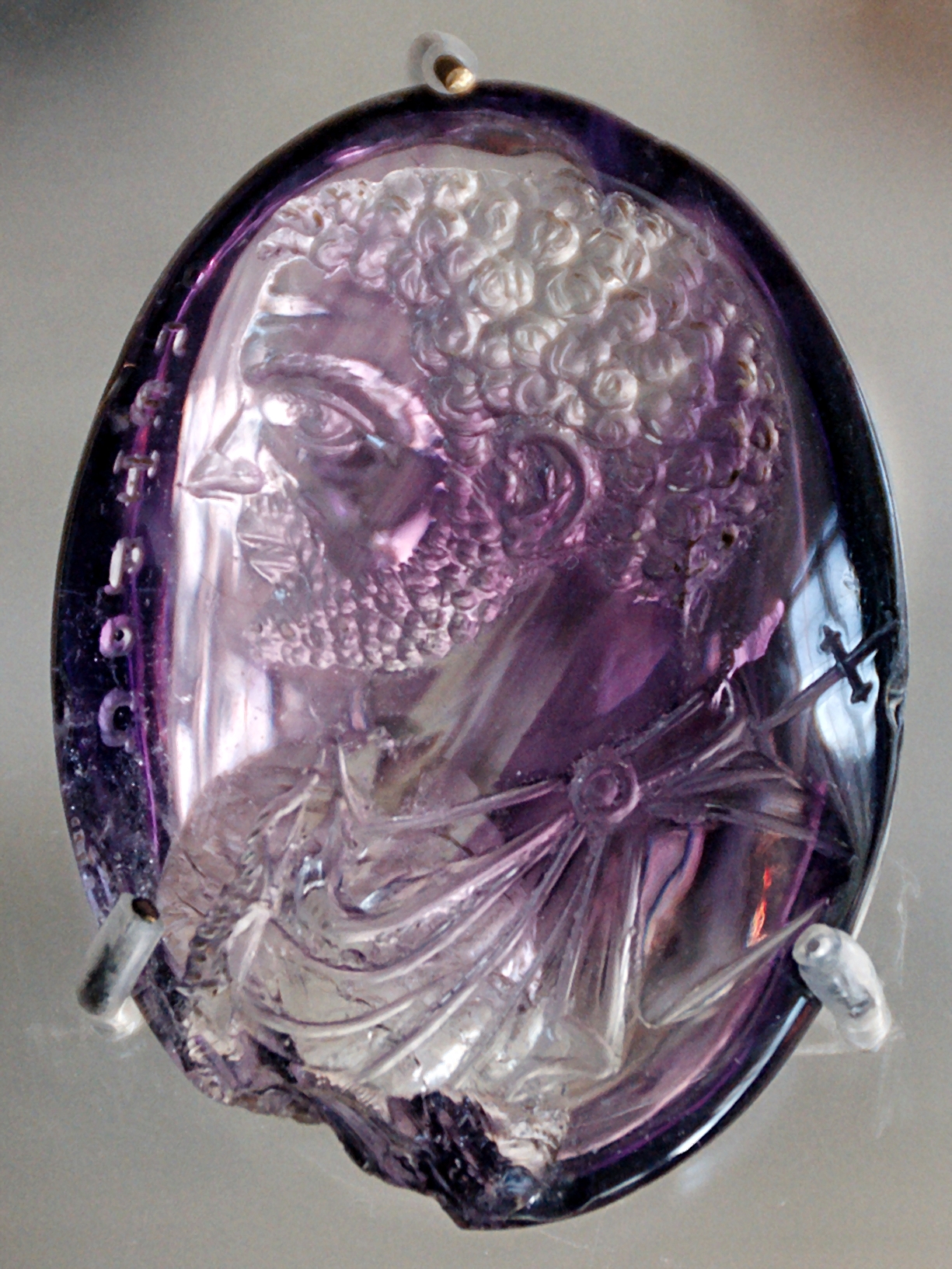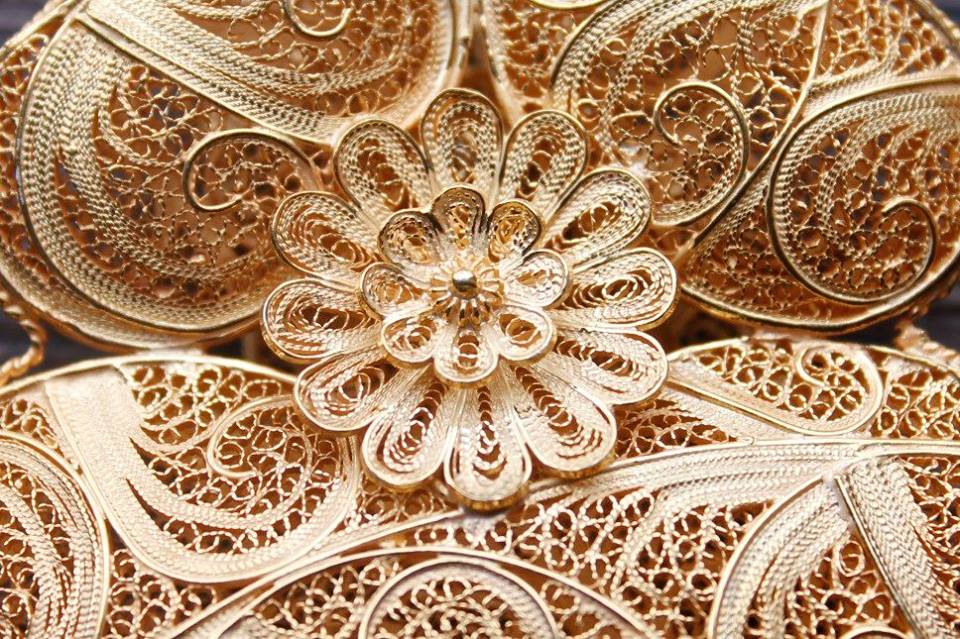|
Bust Of Charlemagne
The Bust of Charlemagne () is a reliquary from around 1350 which contains the Calvaria (skull), top part of Charlemagne's skull. The reliquary is part of the treasure kept in the Aachen Cathedral Treasury. Made in the Mosan region (the valley of the River Meuse), long a centre of high-quality metalwork, the bust is a masterpiece both of late Gothic art, Gothic metalwork and of figural sculpture. The Bust of Charlemagne, as a masterpiece of Mosan art#Metalwork, Mosan goldwork, initiated a height of silver-gilt Realism (arts), naturalistic reliquary busts. Description Created 500 years after the death of Charlemagne, the bust is an idealized representation, the facial structure, hair style and fleur-de-lys crown of which reflect 14th-century, not 9th-century fashion style. The skin is Repoussé and chasing, chased with silver and partially gilt; hair and beard are gilt. Damascening, Damascened silver eagle (heraldry), ''Reichsadler'', the Charge (heraldry), heraldic charge of the ... [...More Info...] [...Related Items...] OR: [Wikipedia] [Google] [Baidu] |
Aachen
Aachen is the List of cities in North Rhine-Westphalia by population, 13th-largest city in North Rhine-Westphalia and the List of cities in Germany by population, 27th-largest city of Germany, with around 261,000 inhabitants. Aachen is located at the northern foothills of the High Fens and the Eifel Mountains. It sits on the Wurm (Rur), Wurm River, a tributary of the Rur (river), Rur, and together with Mönchengladbach, it is the only larger German city in the drainage basin of the Meuse. It is the westernmost larger city in Germany, lying approximately west of Cologne and Bonn, directly bordering Belgium in the southwest, and the Netherlands in the northwest. The city lies in the Meuse–Rhine Euroregion and is the seat of the Aachen (district), district of Aachen ''(Städteregion Aachen)''. The once Celts, Celtic settlement was equipped with several in the course of colonization by Roman people, Roman pioneers settling at the warm Aachen thermal springs around the 1st cen ... [...More Info...] [...Related Items...] OR: [Wikipedia] [Google] [Baidu] |
Damascening
Damascening is the art of inlaying different metals into one another—typically, gold or silver into a darkly oxidized steel background—to produce intricate patterns similar to niello. The English term comes from a perceived resemblance to the rich tapestry patterns of damask silk. The term is also used to describe the use of inlaid copper interconnects in integrated circuits. As its name suggests, damascene gets its name from Damascus, Syria and the ancient artisans that created and exported this craft. Background The technique, while also being used on firearms, has a long history in Japan, where it was used to decorate katana fittings, particularly tsuba. Known as zougan (象嵌) in Japanese, it has developed its own subset of terms to describe the particular patterns, although "shippou-zougan" is an enamelling technique which most Westerners would consider closer to champlevé. Damascened-inlay jewelry, especially of Japanese origin, is sometimes referred to as shakudo f ... [...More Info...] [...Related Items...] OR: [Wikipedia] [Google] [Baidu] |
John II Of France
John II (; 26 April 1319 – 8 April 1364), called John the Good (French: ''Jean le Bon''), was King of France from 1350 until his death in 1364. When he came to power, France faced several disasters: the Black Death, which killed between a third and a half of its population; popular revolts known as ''Jacqueries''; Free company, free companies (''Grandes Compagnies'') of routiers who plundered the country; and English aggression that resulted in catastrophic military losses, including the Battle of Poitiers of 1356, in which John was captured. While John was a prisoner in London, his son Charles V of France, Charles became regent and faced several rebellions, which he overcame. To liberate his father, he concluded the Treaty of Brétigny (1360), by which France lost many territories and paid an enormous ransom. In an exchange of hostages, which included his son Louis I, Duke of Anjou, John was released from captivity to raise funds for Ransom of John II of France, his ransom. U ... [...More Info...] [...Related Items...] OR: [Wikipedia] [Google] [Baidu] |
Franks
file:Frankish arms.JPG, Aristocratic Frankish burial items from the Merovingian dynasty The Franks ( or ; ; ) were originally a group of Germanic peoples who lived near the Rhine river, Rhine-river military border of Germania Inferior, which was the most northerly province of the Roman Empire in continental Europe. These Frankish tribes lived for centuries under varying degrees of Roman hegemony and influence, but after the collapse of Roman institutions in western Europe they took control of a large empire including areas which had been ruled by Rome, and what it meant to be a Frank began to evolve. Once they were deeply established in Gaul, the Franks became a multilingual, Catholic Christian people, who subsequently came to rule over several other post-Roman kingdoms both inside and outside the old empire. In a broader sense much of the population of western Europe could eventually described as Franks in some contexts. The term "Frank" itself first appeared in the third cent ... [...More Info...] [...Related Items...] OR: [Wikipedia] [Google] [Baidu] |
Coronation Of The Holy Roman Emperor
The Holy Roman Emperor received the imperial regalia from the hands of the Pope, symbolizing both the pope's right to crown Christian sovereigns and also the emperor's role as protector of the Catholic Church. The Holy Roman empresses were crowned as well. The Holy Roman Empire was established in 962 under Otto the Great. Later emperors were crowned by the pope or other Catholic bishops. In 1530 Charles V became the last Holy Roman emperor to be crowned by a pope, Clement VII, albeit in Bologna ( Frederick III was the last to be crowned in Rome). Thereafter, until the abolition of the empire in 1806, no further crownings by the pope were held.See also Guy Stair SaintyThe Holy Roman Empire: Introduction. From thAlmanach de la Courwebsite. Retrieved on 14 September 2008. Later rulers simply proclaimed themselves ''Imperator Electus Romanorum'' ("Elected Emperor of the Romans") after their coronation as German king. Preliminaries Before being crowned emperor by the pope, a mon ... [...More Info...] [...Related Items...] OR: [Wikipedia] [Google] [Baidu] |
Charles IV, Holy Roman Emperor
Charles IV (; ; ; 14 May 1316 – 29 November 1378''Karl IV''. In: (1960): ''Geschichte in Gestalten'' (''History in figures''), vol. 2: ''F–K''. 38, Frankfurt 1963, p. 294), also known as Charles of Luxembourg, born Wenceslaus (, ), was Holy Roman Emperor from 1355 until his death in 1378. He was elected King of Germany (King of the Romans) in 1346 and became King of Bohemia (as Charles I) that same year. He was a member of the House of Luxembourg from his father's side and the Bohemian House of Přemyslid from his mother's side; he emphasized the latter due to his lifelong affinity for the Bohemian side of his inheritance, and also because his direct ancestors in the Přemyslid line included two saints. He was the eldest son and heir of John of Bohemia, King of Bohemia and Count of Luxembourg, who died at the Battle of Crécy on 26 August 1346. His mother, Elizabeth of Bohemia (1292–1330), Elizabeth, Queen of Bohemia, was the sister of Wenceslaus III of Bohemia, W ... [...More Info...] [...Related Items...] OR: [Wikipedia] [Google] [Baidu] |
Coat Of Arms Of France
The coat of arms of France is an unofficial emblem of the France, French Republic. It depicts a lictor's fasces upon branches of laurel and oak, as well as a ribbon bearing the national motto of . The full Achievement (heraldry), achievement includes the star and grand collar of the Legion of Honour. This composition was created in 1905 (during the French Third Republic, Third Republic) by heraldic Peintre-graveur, painter-engraver Maurice de Meyère, and it has been used at the Ministry for Europe and Foreign Affairs (France), Foreign Ministry during state visits and for presidential inaugurations. The country is traditionally associated with the Fleur-de-lis, fleurs-de-lis design, which came into use by Kingdom of France, French kings during the High Middle Ages. This design still represents France and the House of Bourbon in the form of Heraldry#Marshalling, marshalling, such as in the arms of Coat of arms of Spain, Spain, Coat of arms of Quebec, Quebec, and Coat of arms of Ca ... [...More Info...] [...Related Items...] OR: [Wikipedia] [Google] [Baidu] |
Fleur-de-lis
The ''fleur-de-lis'', also spelled ''fleur-de-lys'' (plural ''fleurs-de-lis'' or ''fleurs-de-lys''), is a common heraldic charge in the (stylized) shape of a lily (in French, and mean and respectively). Most notably, the ''fleur-de-lis'' is depicted on the flag of Quebec and on the traditional coat of arms of France that was used from the High Middle Ages until the French Revolution in 1792, and then again in brief periods in the 19th century. This design still represents France and the House of Bourbon in the form of Heraldry#Marshalling, marshalling in the arms of Coat of arms of Spain, Spain, Coat of arms of Quebec, Quebec, and Coat of arms of Canada, Canada — for example. Other European nations have also employed the symbol. The ''fleur-de-lis'' became "at one and the same time, religious, political, dynastic, artistic, emblematic, and symbolic", especially in French heraldry. The Mary, mother of Jesus, Virgin Mary and Saint Joseph are among saints often depicted wit ... [...More Info...] [...Related Items...] OR: [Wikipedia] [Google] [Baidu] |
Engraved Gem
An engraved gem, frequently referred to as an intaglio, is a small and usually semi-precious gemstone that has been carved, in the Western tradition normally with images or inscriptions only on one face. The engraving of gemstones was a major luxury art form in the Ancient history, ancient world, and an important one in some later periods. Strictly speaking, ''engraving'' means carving ''in intaglio'' (with the design cut ''into'' the flat background of the stone), but relief carvings (with the design projecting ''out of'' the background as in nearly all cameo (carving), cameos) are also covered by the term. This article uses ''cameo'' in its strict sense, to denote a carving exploiting layers of differently coloured stone. The activity is also called ''gem carving'' and the artists ''gem-cutters''. References to antique gems and intaglios in a jewellery context will almost always mean carved gems; when referring to monumental sculpture, the term counter-relief, meaning the same a ... [...More Info...] [...Related Items...] OR: [Wikipedia] [Google] [Baidu] |
Classical Antiquity
Classical antiquity, also known as the classical era, classical period, classical age, or simply antiquity, is the period of cultural History of Europe, European history between the 8th century BC and the 5th century AD comprising the interwoven civilizations of ancient Greece and ancient Rome, Rome known together as the Greco-Roman world, centered on the Mediterranean Basin. It is the period during which ancient Greece and Rome flourished and had major influence throughout much of Europe, North Africa, and West Asia. Classical antiquity was succeeded by the period now known as late antiquity. Conventionally, it is often considered to begin with the earliest recorded Homeric Greek, Epic Greek poetry of Homer (8th–7th centuries BC) and end with the fall of the Western Roman Empire in 476 AD. Such a wide span of history and territory covers many disparate cultures and periods. ''Classical antiquity'' may also refer to an idealized vision among later people of what was, in Ed ... [...More Info...] [...Related Items...] OR: [Wikipedia] [Google] [Baidu] |
Filigree
Filigree (also less commonly spelled ''filagree'', and formerly written ''filigrann'' or ''filigrene'') is a form of intricate metalwork used in jewellery and other small forms of metalwork. In jewellery, it is usually of gold and silver, made with tiny beads or twisted threads, or both in combination, soldered together or to the surface of an object of the same metal and arranged in artistic motifs. It often suggests lace and remains popular in Indian and other Asian metalwork. It was popular as well in Italian, French and Portuguese metalwork from 1660 to the late 19th century. It should not be confused with ajoure jewellery work, the ajoure technique consisting of drilling holes in objects made of sheet metal. The English word filigree is shortened from the earlier use of ''filigreen'' which derives from Latin meaning thread and grain, in the sense of small bead. The Latin words gave ''filigrana'' in Italian which itself became ''filigrane'' in 17th-century Frenc ... [...More Info...] [...Related Items...] OR: [Wikipedia] [Google] [Baidu] |
Holy Roman Emperor
The Holy Roman Emperor, originally and officially the Emperor of the Romans (other), Emperor of the Romans (; ) during the Middle Ages, and also known as the Roman-German Emperor since the early modern period (; ), was the ruler and head of state of the Holy Roman Empire. The title was held in conjunction with the title of King of Italy#Kingdom of Italy (781–962), King of Italy (''Rex Italiae'') from the 8th to the 16th century, and, almost without interruption, with the title of King of Germany (''Rex Teutonicorum'', ) throughout the 12th to 18th centuries. The Holy Roman Emperor title provided the highest prestige among Christianity in the Middle Ages, medieval Catholic monarchs, because the empire was considered by the Catholic Church to be Translatio imperii, the only successor of the Roman Empire during the Middle Ages and the early modern period. Thus, in theory and diplomacy, the emperors were considered first among equalsamong other Catholic monarchs across E ... [...More Info...] [...Related Items...] OR: [Wikipedia] [Google] [Baidu] |








